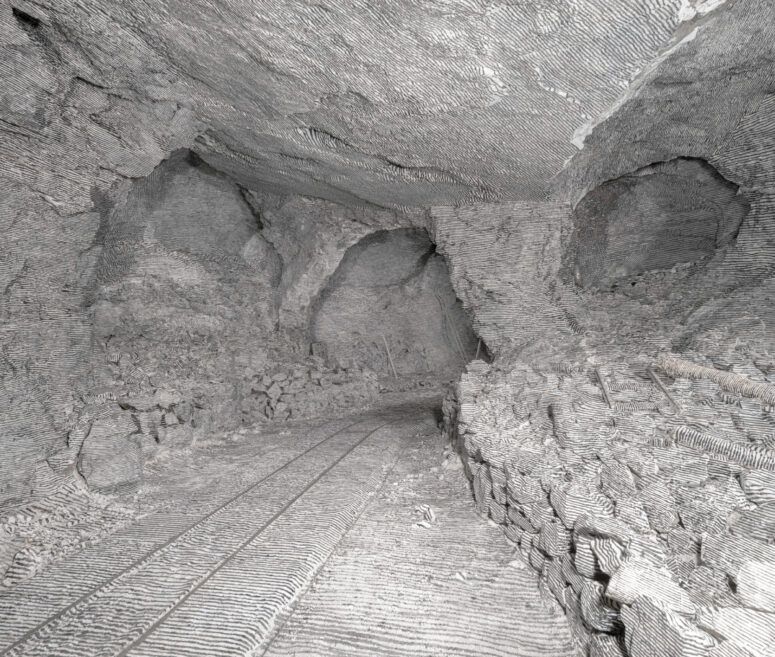In Dossena, in the oldest mining district of the Brembana Valley from which ferrous material and fluorite have been extracted for centuries, German artist Julius von Bismarck (Breisach am Rhein, 1983) creates his fifth landscape painting: a painting both of and in thelandscape, in which the pictorial gesture dissolves the boundary between the subject portrayed and the support on which it is created.
For his intervention, the artist is inspired by the aesthetics of etchings and landscape studies that have characterized the research of many leading figures in art history, from Albrecht Dürer to Caspar David Friedrich, from Paul Cézanne to Paul Klee. In particular, von Bismarck’s main references are Italian vedute, woodcuts and copperplate engravings of the eighteenth and nineteenth centuries, which set out to depict landscapes as realistically as possible.
In a diametrically opposed approach, the artist intervenes on the rock walls inside the mine by creating an “inverted” trompe-l’œil: instead of rendering three-dimensionality through optical illusions, he paints lines and hatches—typical of the engraving techniques of the past—that transform the view of the quarry into a two-dimensional image. An entire portion of the mine’s first tunnel, selected for its perspective qualities and monumental scale, is simplified into an entirely black-and-white landscape, of which the three-dimensionality may then be reconstructed in the visitors’ imaginations.
Von Bismarck, unlike the engravings that circulated in print between the eighteenth and nineteenth centuries, is not interested in portraying the grandeur of the landscape, but in physically entering it by confronting its grandeur, in an action that is at once measurement, struggle, conquest, and transformation. The pictorial stroke, applied directly onto the rock, thus becomes a monumental intervention that, while transient, effectively marks the environment: the pictorial image will slowly fade away over the years through the action of weathering.
In this process, one in which the mountain dissolves into the black lines on a white background of the drawing, the artist deconstructs the history of landscape painting with the intention of exposing its contradictions, showing how the representation of nature has always been filtered through anthropocentric idealizations and perspectives.
Referring in particular to the images printed in newspapers and magazines, circulated for decades throughout Europe between the eighteenth and nineteenth centuries, provided by explorers of overseas lands, particularly from Africa and India (who emphasized the wild nature of the landscapes they traversed) the artist attempts to problematize the role that the media played in spreading the idea of an unspoiled nature ready to be conquered, firstly by travelers and later by colonizers. An idea in some ways still alive today in the imagery promoted by mass tourism.
While mines have long been a typical subject of artistic production, von Bismarck’s intervention in Dossena questions the supposed neutrality of the landscape to highlight its relationship with the human presence that inevitably marks the environment, sometimes irreversibly. Some of the elements visible and incorporated in Landscape Painting (Mine), such as the ladder and other objects used in the past by miners, constitute a necessary incursion to undermine the notion of nature as something other than itself and thus to relocate the human being within it.
His intervention thus intensifies reflection on the relationship between the human and nature, ultimately conceived not as a pre-human or “other” entity, but as a cultural construct that changes throughout history.
The relational aspect was also at the basis of the process that gave rise to the work: as part of the Na.Tur.Arte – L’Area Wilderness Valparina tra ospitalità, Arte e Natura project, the Municipality of Dossena, the Mines Association and the Menna Ortighera Forestry Consortium were, from the earliest stages, indispensable interlocutors with whom the museum established an intense collaboration based on the sharing of intentions and the construction of a common path. The continuous dialogue between the young volunteers and professionals of the Association, and the museum together with the artist, has woven an interweaving of technical and territorial knowledge, rooting the realization of Landscape Painting (Mine) in the cultural, social and geological reality of the place, to which the work from this moment belongs.
Conceived in close relationship with the mining landscape of Dossena, von Bismarck’s intervention—for the execution of which the artist availed himself of the collaboration of Nikita Popescu, Natasha Rivellini and Nicola Zanni—thus aims to trigger new gazes on a geological heritage of extraordinary relevance, strengthening its visibility and public enjoyment. An intervention that intends to give back to the community, first of all, and to the visitors themselves, an opportunity to know and belong to a fascinating place, steeped in history and individual and community stories.





